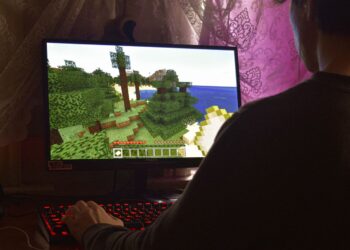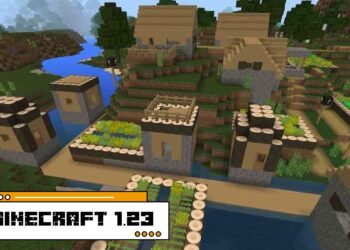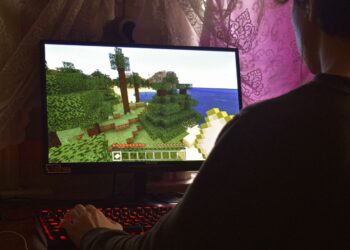Coding for kids is a great way to get them interested in technology and computer science. But where do you start? This guide will tell you everything you need to know to get started coding with your kids.
Introduction
Coding for kids is a crucial skill to have in the future. It teaches youngsters problem-solving, critical thinking, and computational thinking abilities that will serve them well in the future. Furthermore, coding may help open doors to chances in the tech industry, which provides well-paying employment that are expected to grow significantly over the next ten years. Coding teaches students how to break big jobs down into smaller issues that can be tackled methodically and rationally.
Whether you want to introduce programming principles to your kid at a young age or have an older adolescent who wants to learn to code, there are many methods to get started teaching them the fundamentals of programming. This article will include advice on how to begin teaching coding to children, as well as resources for additional study:
 What is coding?
What is coding?
Coding is a method of communicating instructions for a computer or other technological device. Creating websites and applications, operating robots and other digital devices, and generally directing computers what to do are all examples of this. It blends logical thinking with creative problem-solving and allows you to create something concrete.
Coding, at its most fundamental, is a collection of instructions expressed in a language that a machine can comprehend. When you “code” anything, you construct a program that dictates how the computer will do an action or steps. Coding abilities are becoming more crucial in today’s environment, as technology plays an increasingly important part in our lives.
Learning to code may help youngsters develop critical thinking abilities, practice problem solving and logical reasoning, explore their curiosity, produce something tangible they can be proud of, and even prepare them for future employment options:
- Develop critical thinking abilities
- Practice problem solving and logical reasoning
- Explore their curiosity
- Produce something tangible they can be proud of
- Prepare them for future employment options
Types of coding
Coding for kids is an excellent technique to teach digital literacy, problem solving, and critical thinking skills. From basic programs and websites to large video games, coding can be used to build anything. There are many various forms of coding that may be employed while coding for kids, depending on the intended objective.
Clock programming is a sort of coding that is often used while teaching youngsters how to code. Clock programming makes use of clocks, either analog or digital, as a visual signal to assist students learn the fundamentals of programming. The position of each clock on the screen refers to a distinct set of instructions that must be obeyed in order for the program to function properly. This helps youngsters comprehend coding principles as they learn them, as well as allows them to work through difficulties rationally and effectively.
In order to construct more complicated applications, clock programming is often integrated with other kinds of coding languages such as:
- Python
- Java
- JavaScript
Benefits of coding
Coding for kids is an excellent approach to expose young minds to the world of technology and pique their interest in coding and related technologies. Children develop problem-solving abilities, get a better grasp of how computers function, and are better equipped for future employment via coding. Furthermore, coding may help children improve their logical thinking abilities since they must break difficulties down into smaller sections in order to discover solutions.
Aside from the educational advantages of coding, devoting time each day to teach children code helps them to engage in an active kind of learning that may be valuable in everyday situations, such as understanding how trading among villages works in video games like Minecraft or Animal Crossing. Coding teaches children how different actions interact with one another and how information is saved and retrieved when they play games or use programs. When it comes to making judgments in the world around us, this sort of information is vital.
Where to start
If you’re just getting started with coding with a young learner, the best place to start is with the fundamentals. For younger students, this might include teaching coding principles via creative play and discovery. Scratch and other block-based programming languages are excellent places to begin. They employ graphic blocks rather than written instructions, making them more approachable to younger pupils learning the fundamentals of coding.
You should also think about what activities and projects your youngster could like. Is your child interested in making a video game? Create their own website? Make an app? Knowing what kind of project they want to work on can assist you decide which language to utilize. Then, whether it’s online tutorials and seminars or physical instruction manuals and books, it’s critical to locate tools and resources that work best for your student. With the correct materials, you can provide your student with all the assistance they need on their computer science journey.
Choosing a coding language
It might be difficult to know where to begin when selecting a coding language. There are several coding languages and frameworks available, which might be confusing. The sort of project you are working on is an important factor to consider when selecting a coding language. Some programming languages, such as C++ and Python, are more suited to specific sorts of tasks than others. For example, if you’re creating a game or dealing with graphics, C++ may be a better choice.
Another factor to consider is the language’s degree of difficulty. While C++ may be fairly complicated and tough to learn, Python is considerably simpler for beginners and serves as an excellent basis for learning other languages. Furthermore, some languages may not have as many resources accessible expressly for youngsters or those new to coding, so before making your final pick, check to see if there are any tutorials or courses targeted to your ability level.
Finally, the language you select is entirely up to you; just make sure it is appropriate for your project.
Choosing a coding platform
When it comes to selecting a coding platform for kids, there are a few things to bear in mind. Some platforms may be more appropriate than others depending on the child’s age and technological expertise. Scratch and Tynker are popular with younger children because to their simple user interface and drag-and-drop features. Children with more expertise may be better suited to more advanced programming languages such as Python or JavaScript.
Control flow, variables, data structures, and debugging are just a few of the ideas that students may learn via these activities. The easiest approach to determine which coding platform is ideal for your youngster is to try out many possibilities until you discover one that works well.
Tips for teaching coding to kids
Teaching coding to children may help them develop problem-solving and critical thinking abilities, as well as a lifetime love of learning. It may also be quite lucrative for teachers. There are several strategies for teaching coding to children that should be considered while developing a curriculum and teaching style.
One of the finest techniques is to create an engaging atmosphere by involving your students in programming-related activities and conversations. Use visual aids like photographs and colorful diagrams to help convey topics more clearly. Analogies may also assist children comprehend the fundamentals of computer programming.
Another important technique is to divide jobs down into smaller parts and progressively introduce new ideas, such as introducing variables before implementing control structures like loops or conditionals. Early game creation may also be stimulating, since it allows youngsters to master problem-solving abilities while creating the game logic.
Finally, giving hands-on activities such as constructing their own websites or applications may give a more concrete project for kids to strive towards a fulfilling end result.
Keep it fun
Minecraft is a fantastic approach for youngsters to learn coding in a fun and interactive environment. Concrete is one of the most enjoyable projects you can create in Minecraft using code. Concrete demands built-in game aspects, therefore you’ll need to conduct some study before beginning your project.
To manufacture concrete in Minecraft, first create a recipe using sand, gravel, water, and dye. To manufacture concrete powder, combine the components in a 3×3 crafting grid. Next, either straight into the ground while playing or into one of your crafting grids while not playing, add the concrete powder. Finally, take a pail of water to sprinkle on top of the powder and watch it rapidly solidify into concrete blocks. Use this project to practice stuff like color mixing and patterning commands as you continue to code in Minecraft. Making your projects enjoyable can assist your programmer stay engaged and interested in their learning process.
Break it down into small steps
When coding for kids, it’s critical to divide a difficult programming assignment into smaller, more approachable parts. This makes the total work more approachable and invites new developers to participate in the project.
For example, if you want to write a program that fights the Wither, a boss enemy in the game Minecraft, break it down into its components first. Perhaps you’d start by creating a player character, then add weapons and armor, and so on. Once each component has been developed and tested successfully, reassemble them into a single program.
This systematic approach to coding for kids teaches them that making errors is part of the process and how to properly debug their programs as they build them up piece by piece towards success. It also encourages good coding skills like debugging and testing, which kids may use to more difficult projects in the future.
Make it relevant
When teaching children to code, it is critical to ensure that the coding is relevant and enjoyable to them. “Digging Down” is one of the most efficient strategies for doing this. This entails reducing difficult code ideas down into smaller, more digestible portions that youngsters can comprehend and work with.
Digging Down demands instructors to explain why a certain idea or approach should be studied, in addition to breaking complicated topics down into smaller ones. This makes it simpler for the child to establish connections between what they are doing and why it is important in their daily lives or broader initiatives.
Finally, Digging Down should include interesting exercises that might assist reinforce what has been discussed or enable students to creatively use their acquired skills and knowledge.
Resources for learning coding
Learning to code may be a vital skill for any aspiring computer worker, or it can just be a highly enjoyable pastime. There is a multitude of tools accessible to assist individuals interested in learning to code.
- Codecademy is a prominent and beginner-friendly platform that offers free interactive coding courses covering the fundamentals of several popular programming languages.
- Free Code Camp is another useful site that offers free coding classes and projects focused at teaching fundamental web programming skills.
- Code Avengers and Udacity provide extensive courses in particular areas such as iOS app development or HTML5 game creation for people interested in learning something more complicated, such as game development or app design.
- To go further into more sophisticated areas, edX provides a selection of courses from prominent institutions on subjects such as Machine Learning and Artificial Intelligence.
- Finally, for individuals who wish to take their skills offline, attending local meetings or courses that concentrate on teaching coding principles may be quite valuable.
With so many resources accessible both online and offline, anybody can become an excellent developer.
Online courses
There are many online courses available for youngsters who want to learn how to create a cake in the famous video game Minecraft. These classes teach you how to make your own cake, from collecting the essential materials to baking and decorating it. They will also teach the principles of coding, such as how to write code and apply it to construct game elements.
Enrolling in an online course allows children to learn not just how to construct a cake in Minecraft, but also coding abilities that will help them as they go through their gaming adventures. Kids may acquire all the tips and techniques for remaining on top of their game and enjoying every minute of it with the aid of online classes.
Books
Books may help your children get interested in coding and polish their abilities. There are lots of books available for kids of different ages and skills, whether they wish to learn coding explicitly or basic programming knowledge.
Here are some of the most popular titles:
- Coding for Kids: An Introduction to Programming for Children
- Coding With Java For Kids
- Python Programming For Kids
- Computer Science Unplugged
These books address a broad variety of subjects, from fundamental ideas like variables, loops, and functions to more advanced ones like artificial intelligence. Coding books also educate children to important coding language and tools, which may aid in their knowledge when utilizing online resources such as Codecademy or Toolbox. Furthermore, many of these books provide simple explanations as well as pleasant activities that make learning interesting and rewarding for today’s young brains.
Games
It is critical for the instructor to engage the student in interactive activities and games at this stage of teaching coding for kids. Games may be a useful approach to communicate topics and ideas while also helping students learn fundamental principles. This might range from problem-solving games to coding challenges related to the subject being discussed.
The instructor must ensure that their student is engaged in ways that are suitable for their level of understanding and knowledge. Questions may be used to assess a student’s understanding of the subjects taught, offering rapid feedback on whether or not they have comprehended. Making questions enjoyable and relevant to game play may help keep students interested and motivated throughout coding courses, propelling them to better success in this topic.
Conclusion
Coding is an effective tool for teaching children to think critically, solve issues, and create meaningful projects. When learning to code, it is critical to begin with the fundamentals and progressively build up their abilities as they get more familiar with coding principles. Parents and caregivers may provide their children the greatest chance of success by providing them with many materials, support, and opportunity to practice coding.
Coding also teaches young people about the digital environment in which they live and offers them the courage to explore technology creatively. Coding helps children gain confidence in their talents by teaching them problem-solving skills that can be applied to any topic, including computer science. Coding, with the correct direction and support from adults, may open up a world of possibilities for children of all ages, laying the groundwork for a future in technology or any other sector in which they are interested.




 What is coding?
What is coding?












